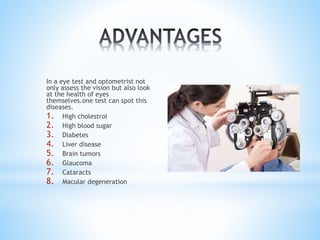Eyecare Near Me: Comprehensive and Reliable Vision Solutions
Eyecare Near Me: Comprehensive and Reliable Vision Solutions
Blog Article
The Duty of Advanced Diagnostic Tools in Identifying Eye Disorders
In the realm of ophthalmology, the usage of innovative diagnostic tools has transformed the very early identification and monitoring of various eye conditions. As the need for precise and timely diagnoses continues to grow, the combination of sophisticated devices like optical coherence tomography and aesthetic field screening has come to be crucial in the world of eye care.
Significance of Early Medical Diagnosis
Early medical diagnosis plays a pivotal role in the efficient administration and treatment of eye problems. By discovering eye disorders at a very early stage, medical care suppliers can use suitable therapy plans tailored to the details condition, inevitably leading to much better end results for clients.
Modern Technology for Discovering Glaucoma
Cutting-edge analysis technologies play a vital role in the very early discovery and monitoring of glaucoma, a leading reason of irreparable blindness worldwide. One such innovation is optical comprehensibility tomography (OCT), which offers thorough cross-sectional images of the retina, permitting the measurement of retinal nerve fiber layer thickness. This dimension is important in evaluating damages brought on by glaucoma. One more innovative device is visual area screening, which maps the sensitivity of an individual's aesthetic field, assisting to spot any type of locations of vision loss characteristic of glaucoma. Furthermore, tonometry is utilized to gauge intraocular pressure, a significant risk variable for glaucoma. This test is essential as elevated intraocular stress can lead to optic nerve damages. More recent modern technologies like the use of synthetic knowledge formulas in assessing imaging data are showing appealing results in the very early detection of glaucoma. These innovative analysis devices make it possible for ophthalmologists to identify glaucoma in its early phases, permitting for timely intervention and much better management of the illness to avoid vision loss.
Duty of Optical Comprehensibility Tomography

OCT's capability to evaluate check out here retinal nerve fiber layer density enables for specific and unbiased measurements, aiding in the early detection of glaucoma also before visual area problems come to be evident. In general, OCT plays a vital duty in enhancing the analysis accuracy and management of glaucoma, eventually adding to much better end results for individuals at threat of vision loss.
Enhancing Diagnosis With Visual Area Screening
An essential element in detailed sensory analyses, visual field screening plays an essential function in enhancing the diagnostic process for various eye conditions. By assessing the complete extent of a person's aesthetic field, this examination gives important info about the practical honesty of the whole aesthetic path, from the retina to the aesthetic cortex.
Aesthetic area testing is especially important in the diagnosis and management of problems such as glaucoma, optic nerve disorders, and various neurological conditions that can impact vision. With quantitative measurements of peripheral and main vision, clinicians can detect subtle changes that might indicate the existence or development of these conditions, even before noticeable symptoms occur.
Additionally, visual field screening permits the tracking of treatment efficiency, assisting eye doctors tailor restorative interventions to private clients. eyecare near me. By tracking changes in aesthetic field performance gradually, healthcare carriers can make educated choices regarding changing drugs, advising medical interventions, or executing various other appropriate measures to maintain or boost a person's visual function
Managing Macular Degeneration

Conclusion
In conclusion, advanced diagnostic devices play a critical function in recognizing eye conditions beforehand. Technologies such as Optical Comprehensibility Tomography and aesthetic field testing have significantly enhanced the accuracy and efficiency of detecting problems like glaucoma and macular deterioration. Early detection allows for timely treatment and management of these conditions, ultimately resulting in better outcomes for patients. It is important for healthcare professionals to remain updated on these developments to provide the very best feasible take care of their people. eyecare near me.
Report this page